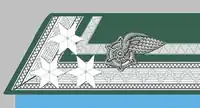Stabswachtmeister
Stabswachtmeister (short: StWm) is in the Austrian Bundesheer a NCO-rank. As lowest grade of the Staff-NCO rank group he is normally dedicated to command a platoon or to serve in a military staff appointment (assignment group M BUO 1 / professional NCO; respectively M ZUO 1 / longer-serving volunteer). However, he might also be assigned to command a military squad (assignment group M BUO 2 / longer-serving volunteer).
| |||
| Rank insignia | Austrian Bundesheer | ||
| Introduction | 1913 | ||
| Rank group | Stabsunteroffizier | ||
| Army / Air Force | Stabswachtmeister | ||
| Navy | no equivalent | ||
| Lower: Higher: | Oberwachtmeister | ||
| Oberstabswachtmeister | |||
| NATO equivalent | OR-7[1] | ||
During United Nations missions and in NATO Partnership for Peace the rank Stabswachtmeister will be designated in English with Staff Sergeant (SSG) and is equivalent to NATO-Rang code OR-7.
Besides Austria today, the rank was also used for example in Germany and in the k.u.k. Army.
With the foundation of the Austrian Bundesheer in March 1920 the «Stabswachtmeister» was introduced to all army branches of service. The OR7-rank Stabsfeldwebel of the generic infantry (de: Fußtruppen) was abolished.
- See also
k.u.k. Austro-Hungarian Army
The Stabswachtmeister rank was introduced in 1913 to the cavalry of the k.u.k. Army. As well as the Offiziersstellvertreter (en: officer deputy rank), this rank has been counted to the higher NCO-ranks (also: Unteroffiziere with port épée / port épée NCOs) since 1915. According to the Austria-Hungarian rank table it was equivalent to the rank class XII. However, according to the modern days NATO-Rang code system, it might have been comparable to NCO-rank OR6[1]/ 1st sergeant ranks in Anglophone armed forces.
In the k.u.k. Austro-Hungarian Army Stabswachtmeister was equivalent to:
- Stabsfeldwebel (en: 1st sergeant) of the infantry,
- Stabsoberjäger (en: Rifles 1st sergeant) of the mountain troops,
- Stabsfeuerwerker (en: Artillery 1st sergeant) of the artillery,
| Junior rank Wachtmeister |
(Austro-Hungarian armed forces rank) Stabswachtmeister |
Senior rank Kadett-Offiziersstellvertreter Kadett |
Then rank insignia was a gorget patch on the stand-up collar of the so-called Waffenrock (en: uniform jacket), and consisted of three white stars on 13 mm ragged imperial-yellow silk galloon, with 2mm broad black middle strap, 3mm above a 6mm braiding (since June 1914: silver galloon with silk stars). The gorget patch and the stand-up collar showed the particular Waffenfarbe (en: corps colour).
| Designation | Performance 1913-1914 | |||
|---|---|---|---|---|
 |
 |
 |
 | |
| Paroli | ||||
| Rank description | Stabsfeldwebel | Stabsfeuerwerker Artillery |
Stabswachtmeister Dragoon |
Stabsoberjaeger Mountain infantry |
| (Hungarian) | (Törzsőrmester) | |||
| Designation | Performance 1914-1918 | |||
|---|---|---|---|---|
 |
 |
 |
 | |
| Rank insignia collar | ||||
| Rank description | Stabsfeldwebel Stabswachtmeister |
Stabsfeuerwerker Artillery |
Stabsfeldwebel Railway regiment |
Stabsoberjaeger Mountain infantry |
| (Hungarian) | (Törzsőrmester) | |||
- Stabswachtmeister in k.u.k adjustation
 Stabswachtmeister train troops 1913-1914 (more than 9 years in service)
Stabswachtmeister train troops 1913-1914 (more than 9 years in service) Stabswachtmeister train troops until 1914
Stabswachtmeister train troops until 1914 Stabswachtmeister stude since 1914
Stabswachtmeister stude since 1914
- see also
Germany
In the today's German Bundeswehr there is no rank designation «Stabswachtmeister». However, the equivalent to that OR-7 rank would be Hauptfeldwebel OR7.
In the German Reichswehr as well as Wehrmacht the designation of the OR7-Stabsfeldwebel rank of Cavalry and Artillery was «Stabswachtmeister» until 1945.
«Stabswachtmeister» was also a German police rank.
| Junior Rank Wachtmeister (Feldwebel) |
|
Senior Rank Leutnant (en: 2nd Lieutenant) |
- See also
Nationale People’s Army
In the GDR National People's Army (NPA) the OR7-rank «Stabswachtmeister» was replaced by the universal rank designation Stabsfeldwebel. The equivalent rank of the Volksmarine (en: GDR Navy) was the Stabsobermeister of the Volksmarine.
| Junior Rank Wachtmeister (Feldwebel) |
National People's Army rank Stabswachtmeister (Stabsfeldwebel) |
Senior Rank Unterleutnant (en: Under lieutenant) |
- See also
References
- The abbreviation "OR" stands for "Other Ranks / fr: sous-officiers et militaires du rang / ru:другие ранги, кроме офицероф"
- Die Streitkräfte der Republik Österreich, 1918-1968, Heeresgeschichtliches Museum, Militärwissenschaftliches Institut, 1968.


